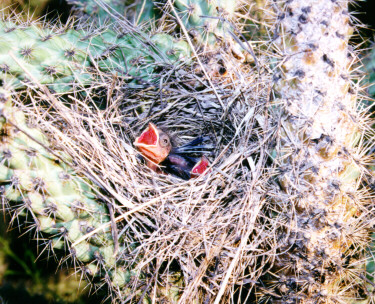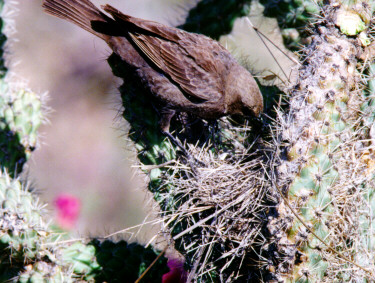Rufous-wing Sparrow Nest Photographs and Cowbird
Photos by Earle Robinson, May 1998
 The nest shown in these photographs was found by George Hentz during Arizona Breeding Bird Atlas work in south-central Arizona. Because of the paucity of nest photographs for this species, we looked at George's discovery as a great opportunity to document the nest construction and cactus preference so it could be used to help us find other nests. Earle volunteered to photograph the nest using a remote camera trigger so the birds would not be disturbed. This technique works well because a person is not near the nest and the adult that comes to the nest will soon ignore the camera that is a short distance away. Earle waited for an adult to visit the nest and took the photograph shown below.
The nest shown in these photographs was found by George Hentz during Arizona Breeding Bird Atlas work in south-central Arizona. Because of the paucity of nest photographs for this species, we looked at George's discovery as a great opportunity to document the nest construction and cactus preference so it could be used to help us find other nests. Earle volunteered to photograph the nest using a remote camera trigger so the birds would not be disturbed. This technique works well because a person is not near the nest and the adult that comes to the nest will soon ignore the camera that is a short distance away. Earle waited for an adult to visit the nest and took the photograph shown below.
 Look carefully at the bird standing on the edge of the nest. Compare this bird with the photograph on the previous page. Once you do the comparison it should be apparent that the bird at the nest is not a Rufous-wing Sparrow. In the nest are the baby birds shown above. This bird is looking in the nest and it can see the baby birds present. What is this bird and what is it doing?
Look carefully at the bird standing on the edge of the nest. Compare this bird with the photograph on the previous page. Once you do the comparison it should be apparent that the bird at the nest is not a Rufous-wing Sparrow. In the nest are the baby birds shown above. This bird is looking in the nest and it can see the baby birds present. What is this bird and what is it doing?
Our first thought was that this was a mis-identification from the beginning. Perhaps this was the nest of another sparrow, such as a Cassin's. They are a drab bird much like the one in this photo. However, there is enough of the bird in the photograph to pretty much rule out a Cassin's Sparrow, also, the nest was present in late April and this was too early for Cassin's. What else could it be? Brown-headed Cowbird comes to mind, but that seems very strange, the nest is full of baby birds already. The Brown-headed Cowbird needs a nest with eggs not baby birds, that nest is too far along to be useful. Earle took three photographs of the bird at the nest. None of the photos shows a bird carrying food to the nest, which is what you would expect in this situation. All the evidence points to a Brown-headed Cowbird which is what we believe this bird is. It has been caught in the act of checking out a nest to see if there are eggs present. Perhaps if one of the eggs were still intact we would also have a picture of the cowbird laying her egg. In any case, this is one of those completely unforseen events in wildlife photography that is not discovered until after the pictures come back from the lab. If you want to photograph a cowbird checking out a nest it might take months before you were successful. With this one photograph we have learned a little more about Brown-headed Cowbirds and how they will inspect nests with eggs that have already hatched. We also know that Rufous-wing Sparrows are viewed as a potential host species. Had we known that it was a cowbird at the nest, at the time the photograph was taken, we could have made additional nest visits to check for cowbird chicks. In this case it seems likely that the cowbird would reject this nest for another with eggs. But who knows? Once I saw a female Brown-headed Cowbird land at the cavity edge of an active Gila Woodpecker nest in a Saguaro, and look inside. What is that all about? Would there be any hope for the survival of a Brown-headed Cowbird chick in a Gila Woodpecker nest? Or are there conditions when the cowbird is so desperate to get rid of one of the 40 eggs laid each year that it will take any nest regardess of the consequences. This seems unlikely because a tendency to use unproductive hosts would rapidly remove the genes responsible for unwise nest selection from future generations. Questions like these are of more than academic interest. North American songbirds are under tremendous pressure from cowbirds, and have been since the bison were removed from the great plains. One way to reduce some of that pressure is to use fake nests that cowbirds will use, thereby removing some of the eggs from real nests. How good does a fake nest have to be in order to fool a cowbird? Does the cowbird have to see a "bird" leave the fake nest before it will deposit an egg? If a method was devised that worked, how many generations would it be successful before the cowbirds no longer accepted fake nests? Which species would be suited best as a model for fake nest tests? How would you measure the success of the tests and how long do you need to run tests before you can trust the results? In areas where there are breeding endangered species, like the Willow Flycatcher, a trap is set and checked daily to catch Brown-headed Cowbirds. Although the daily trap monitoring is very expensive, it is one of the best ways to increase breeding success.
Copyright Greg Clark, 1998
update 8/2012
 The nest shown in these photographs was found by George Hentz during Arizona Breeding Bird Atlas work in south-central Arizona. Because of the paucity of nest photographs for this species, we looked at George's discovery as a great opportunity to document the nest construction and cactus preference so it could be used to help us find other nests. Earle volunteered to photograph the nest using a remote camera trigger so the birds would not be disturbed. This technique works well because a person is not near the nest and the adult that comes to the nest will soon ignore the camera that is a short distance away. Earle waited for an adult to visit the nest and took the photograph shown below.
The nest shown in these photographs was found by George Hentz during Arizona Breeding Bird Atlas work in south-central Arizona. Because of the paucity of nest photographs for this species, we looked at George's discovery as a great opportunity to document the nest construction and cactus preference so it could be used to help us find other nests. Earle volunteered to photograph the nest using a remote camera trigger so the birds would not be disturbed. This technique works well because a person is not near the nest and the adult that comes to the nest will soon ignore the camera that is a short distance away. Earle waited for an adult to visit the nest and took the photograph shown below. Look carefully at the bird standing on the edge of the nest. Compare this bird with the photograph on the previous page. Once you do the comparison it should be apparent that the bird at the nest is not a Rufous-wing Sparrow. In the nest are the baby birds shown above. This bird is looking in the nest and it can see the baby birds present. What is this bird and what is it doing?
Look carefully at the bird standing on the edge of the nest. Compare this bird with the photograph on the previous page. Once you do the comparison it should be apparent that the bird at the nest is not a Rufous-wing Sparrow. In the nest are the baby birds shown above. This bird is looking in the nest and it can see the baby birds present. What is this bird and what is it doing?